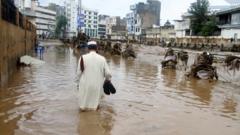Heavy monsoon rains have caused significant destruction across Pakistan and Pakistan-administered Kashmir, with at least 307 fatalities recorded to date. The majority of the deaths occurred in the Khyber Pakhtunkhwa province, where severe landslides and flooding have wreaked havoc. Confirmed reports indicate at least 74 homes damaged and a tragic helicopter crash resulted in the deaths of its five crew members while engaged in rescue efforts.
Fatalities have also been reported in Pakistan-administered Kashmir (nine deaths) and the Gilgit-Baltistan region (five deaths), as emergency responders continue to search for survivors amid rising water levels. Government forecasts suggest that heavy rainfall will persist until August 21, further exacerbating the crisis in the northwest of the country, where numerous areas have been declared disaster zones.
Describing the calamity, a survivor from Buner recounted the frightening moments as floods swept through, evoking fear of impending doom. The Chief Minister of Khyber Pakhtunkhwa, Ali Amin Gadapur, confirmed that the M-17 helicopter crashed due to severe weather conditions while en route to the affected Bajaur district, which borders Afghanistan. In a tragic reflection of the disaster's impact, many residents gathered in mourning as excavators worked through mud-covered hills in search of missing individuals.
In the Indian-administered territory of Kashmir, rescuers have been recovering bodies from areas devastated by flooding, which has claimed at least 60 lives in one incident. Monsoon rains in South Asia, occurring between June and September, contribute to approximately three-quarters of the region’s annual rainfall, making flooding and landslides an unfortunate reality. This year alone, 650 people have perished due to related disasters, with Punjab province seeing an increase of 73% in rainfall and a significant rise in casualties compared to previous monsoon seasons.
Scientific assessments indicate that climate change is amplifying the frequency and severity of such weather scenarios. In northern Pakistan, climate-induced glacial melting contributes to destabilizing the mountain terrain, resulting in increased landslides and flooding. While the precise triggers of the current disaster remain under investigation, experts suggest that glacial melt is a significant factor driving these extreme weather events.




















